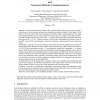Free Online Productivity Tools
i2Speak
i2Symbol
i2OCR
iTex2Img
iWeb2Print
iWeb2Shot
i2Type
iPdf2Split
iPdf2Merge
i2Bopomofo
i2Arabic
i2Style
i2Image
i2PDF
iLatex2Rtf
Sci2ools
IMA
2007
Springer
2007
Springer
New Branch Prediction Vulnerabilities in OpenSSL and Necessary Software Countermeasures
Abstract. Software based side-channel attacks allow an unprivileged spy process to extract secret information from a victim (cryptosystem) process by exploiting some indirect leakage of “side-channel” information. It has been realized that some components of modern computer microarchitectures leak certain side-channel information and can create unforeseen security risks. An example of such MicroArchitectural Side-Channel Analysis is the Cache Attack — a group of attacks that exploit information leaks from cache latencies [4, 7, 13, 15, 17]. Public awareness of Cache Attack vulnerabilities lead software writers of OpenSSL (version 0.9.8a and subsequent versions) to incorporate countermeasures for preventing these attacks. In this paper, we present a new and yet unforeseen side channel attack that is enabled by the recently published Simple Branch Prediction Analysis (SBPA) which is another type of MicroArchitectural Analysis, cf. [2, 3]. We show that modular inversion — a critic...
| Added | 08 Jun 2010 |
| Updated | 08 Jun 2010 |
| Type | Conference |
| Year | 2007 |
| Where | IMA |
| Authors | Onur Aciiçmez, Shay Gueron, Jean-Pierre Seifert |
Comments (0)

